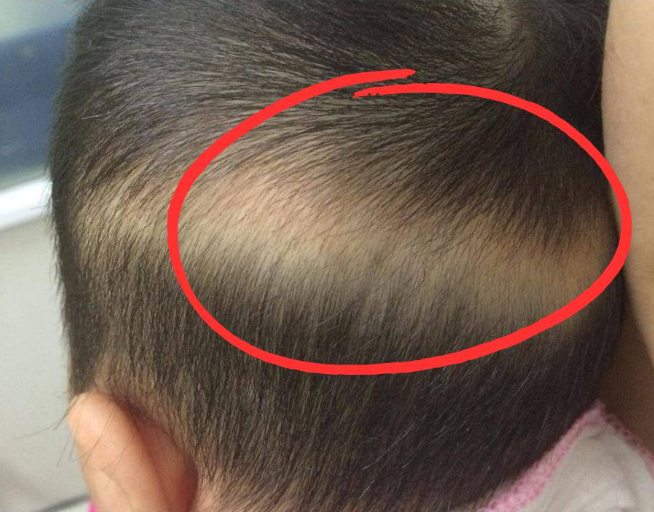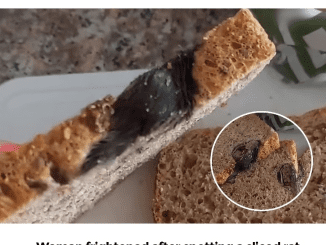It’s always alarming for parents to notice unusual patterns in their child’s development. One such concern is when a baby’s hair begins to fall out in an arc around the back of the neck. While some hair loss is normal for babies, the specific pattern of hair loss resembling a ring can be indicative of underlying health issues. In this article, we’ll explore what this type of hair loss could mean, its potential causes, and what you can do to manage it effectively.

Understanding Hair Loss in Babies: The Arc Pattern
Hair loss in the shape of an arc around the back of a baby’s head is often seen between the ages of 3 to 6 months. It typically manifests as clumps of hair falling out at the roots, leaving a distinctive ring-like pattern. This condition is often accompanied by other symptoms, such as:
- Excessive crying
- Sweating, especially at night
- Difficulty sleeping or frequent startling during sleep
- Wide, slow-closing fontanelle (soft spot) on the head
- Soft or flattened skull shape
- Constipation
These accompanying symptoms can offer important clues about the root cause of the hair loss.
Possible Causes of Ring-Like Hair Loss in Babies
If your baby is experiencing this type of hair loss, it’s essential to understand the potential causes. While some causes are mild and manageable, others may require medical intervention.
1. Hormonal Imbalance in the Body
Hormonal imbalance can be one of the primary causes of hair loss in newborns. This can happen when there’s a natural shift in hormones after birth.
- How It Happens: After birth, a baby’s hormone levels adjust as they transition from the womb to the outside world. Hormonal changes can affect hair growth, leading to shedding or thinning in certain areas.
- What to Do: While hormonal changes are generally temporary, ensuring the mother’s diet is rich in nutrients can help support the baby’s overall health. Keep an eye on the baby’s development and consult a pediatrician if the hair loss persists or worsens.
2. Rickets and Malnutrition: A Common Culprit
Hair loss in a ring-like pattern can also be a sign of rickets, a condition caused by a deficiency of vitamin D and calcium. Rickets is often associated with malnutrition, lack of sunlight exposure, or insufficient nutrients in breast milk.
- Signs to Watch For: In addition to hair loss, babies with rickets may show signs like soft bones, delayed growth, and frequent illnesses. They may also exhibit irritability, excessive sweating, and a flattened skull due to soft bones.
- What to Do: Addressing rickets and malnutrition involves a combination of diet changes and sun exposure. Ensure the baby gets daily sun exposure in the morning when UV rays are less harsh. Vitamin D supplements may also be recommended by a healthcare professional.
3. Sleeping Position: An Overlooked Factor
Babies often sleep in the same position for extended periods, which can contribute to hair loss in specific areas.

- Why It Happens: Constant friction between the baby’s head and the pillow or bedding can lead to hair loss at the back of the head. This is especially common in babies who sleep on their backs and experience more contact in that area.
- What to Do: Try adjusting the baby’s sleeping position periodically. Encourage tummy time during the day to reduce pressure on the back of the head, which can help prevent hair loss and promote healthy head shape.
4. Nutritional Deficiencies in the Mother or Baby
The baby’s nutrition is highly dependent on the mother’s diet, especially if the baby is breastfed. Deficiencies in key nutrients can manifest as hair loss.
- Essential Nutrients: Protein, vitamins, calcium, and vitamin D are critical for hair growth and overall development. Lack of these nutrients can lead to hair thinning and ring-like hair loss in babies.
- What to Do: Ensure that both mother and baby are getting adequate nutrition. The mother should consume a balanced diet rich in proteins, leafy greens, fruits, and vitamin D. If the baby is formula-fed, ensure that the formula contains the necessary nutrients for healthy growth.
5. Ringworm of the Scalp: A Less Common Cause
While less common in babies, ringworm of the scalp, also known as tinea capitis, can cause hair to fall out in patches, including the arc pattern around the neck.
- What It Looks Like: In addition to hair loss, you may notice red, scaly patches or a rash on the scalp. This condition requires prompt medical attention, as it is a fungal infection that needs treatment.
- What to Do: If you suspect ringworm, consult a pediatrician immediately. Avoid self-diagnosis and over-the-counter treatments, as they may not be suitable for infants.
What Parents Can Do When Their Child Experiences Ring-Like Hair Loss
If you notice significant hair loss in an arc pattern, there are several steps you can take to address the issue and support your child’s hair growth and overall health.
1. Ensure Proper Nutrition for Both Mother and Baby
Good nutrition is fundamental to healthy hair growth.
- For Mothers: If you’re breastfeeding, ensure your diet is rich in proteins, iron, vitamins, and water. Foods like leafy greens, eggs, nuts, and dairy can help boost your nutrient intake and improve milk quality.
- For Babies: If your baby is on formula, make sure it’s fortified with vitamins and minerals. If you’re concerned about nutritional deficiencies, consult a pediatrician for supplements, such as vitamin D drops, to support bone and hair health.
2. Change Your Baby’s Sleeping Position Regularly

Adjust your baby’s sleeping position to prevent prolonged friction on one side of the head.
- How to Do It: Gently turn your baby’s head to different sides during sleep or encourage tummy time while awake to relieve pressure on the back of the head.
- Keep the Environment Comfortable: Ensure the sleeping area is well-ventilated and not too warm, as excessive sweating can worsen hair loss.
3. Seek Medical Advice for Persistent Hair Loss
If your child’s hair loss does not improve within six months or if other symptoms develop, seek professional medical advice.
- Red Flags: Look out for red, scaly patches, bald spots, or excessive crying and discomfort. These could be signs of underlying health issues that need to be diagnosed and treated.
- Do Not Self-Medicate: Never administer medication without consulting a pediatrician. Children’s bodies are sensitive, and even minor dosage errors can have serious consequences.
Conclusion: Don’t Ignore Ring-Like Hair Loss in Children
Hair loss in an arc pattern around a baby’s neck is not always a cause for panic, but it should not be ignored either. It can be a symptom of various issues, from minor sleeping habits to more serious conditions like rickets or fungal infections. Early diagnosis and intervention are key to ensuring your child’s well-being and healthy development. By ensuring proper nutrition, adjusting sleeping positions, and seeking medical advice when needed, you can support your child’s healthy hair growth and overall development.


